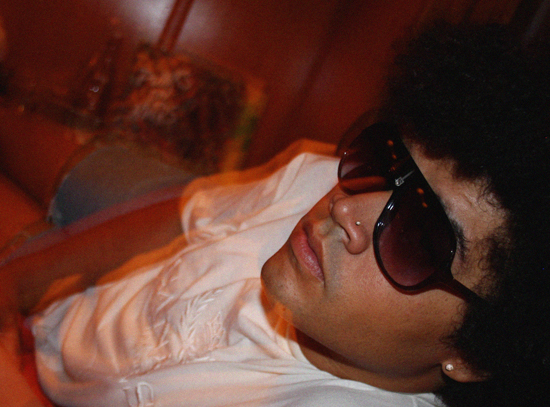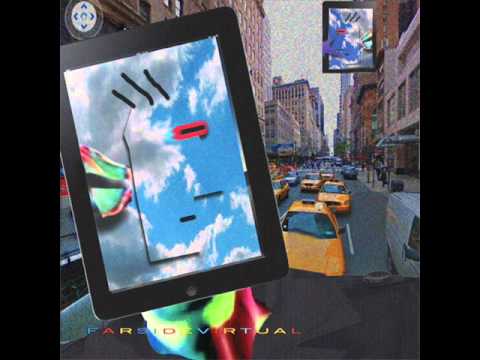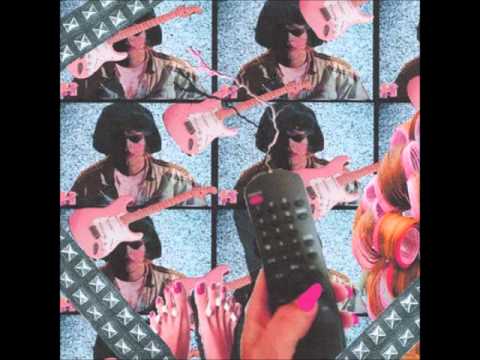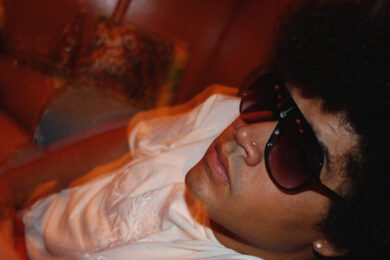It might not be a particularly easy (or often even enjoyable) listen, but James Ferraro’s Far Side Virtual has proved to be one of the most remarkable albums of the year. With its release in November, the former member of hugely influential noise duo The Skaters took a dramatic step away from the ultra low-fidelity, battered dreamscapes of his previous material in favour of razor digital clarity. A symphony of sixteen spiraling, arpeggiated miniatures, punctuated by the recognisable whooosh and clunk of Windows idents and voices from Second Life, it was at once exhausting and fascinating, and felt very much like the logical next step onward from his earlier work.
Ferraro’s music has always dealt with aspects of modern society, albeit in much lower, noisier definition than on Far Side Virtual. As his work with Spencer Clark in The Skaters was tailing off, he embarked on a hugely prolific rush of self-released records under a variety of different pseudonyms, each of which tackled current paradigms of (especially US) society in a different way. His method is generally to stretch out facets of life into grossly exaggerated, distended versions of reality, and in doing so lay bare the deeply unsettling truths beneath the facade: the grunting iron-pumping gym gargoyles of his Edward Flex recordings; the sad, featureless suburban sprawl of Last American Hero (perhaps his most immediately accessible recording); the lonely astral expanses of Pixarni, viewed through a virtual reality lens.
Far Side Virtual, then, deals with an accelerated society, one where advanced telecommunications force people, places, art and sound together into concentrated masses. In keeping with the adrenalised nature of net-assisted life it’s frequently an exhausting listen, and though it’s lost the muddy coating of his earlier work (generally recorded using battered old cassettes, guitars, keyboards and looped voice), it’s probably his most challenging record so far. This week Ferraro has just followed Far Side Virtual up with a free mixtape under the name BEBETUNE$. Like FSV it works with predominantly digital, computer-generated sounds, but uses them to put together a fifty minute set of booming, sample-ridden hip-hop instrumentals. Again fond of distorting the usual tropes, it finds him remixing Gang Gang Dance, and twisting autotuned R’n’B vocal performances into wordless, hyper-sexualised and deeply unsettling moans. It’s a far easier and more immediately enjoyable listen than FSV. Like that record, though, its head-on addressing of the world we live in further cements Ferraro’s importance as one of the most exploratory and pertinent underground musicians currently operating (more on that in yesterday’s Wreath Lecture).
This interview took place via back-and-forth email exchange (appropriately) around the time of FSV‘s release, so sadly there was no chance to ask Ferraro more about his BEBETUNE$ project. However, it sheds a great deal of light on the ideas, concepts and processes that led to the creation of FSV, and how it’s linked with the rest of his music.
Firstly, I wanted to ask about the way the new record came together. Considering you’ve been so prolific for the last few years, it’s been quite interesting to hear nothing new from you for quite a while, followed by something that’s sonically quite different to a lot of your older material. How long did it take to come together, and did you make a conscious choice not to put anything out while this was forming?
James Ferraro: My original idea for Far Side Virtual was to make an album collected in 16 ringtones that you could download to your cell phone and listen to that way. I just had some ideas for ringtones floating in my head. And I would imagine what their titles would be, especially as they would appear on someone’s illuminated mobile phone screen as they bought them. The two elements (ringtone + title) started to represent a kind of haiku. The "haikus" together made a still life, an aerial view of our digital society.
Each track is – for the lack of a better word – an element of society, the album being the whole of this society. Musically it’s a PIXAR meme. Rubbery plastic symphony for global warming, dedicated to the Great Pacific Garbage Patch. This is ringtone music meant to be experienced on the post-structuralist medium, the smartphone.
There’s something intrinsically throwaway about ringtones. Do you feel like the individual tracks on FSV have something of that transience to them?
JF: Like I was saying, the music on FSV mimics ring tones. It’s meant to be experienced on your cell phone but isn’t authentically them, because they’ve been elevated to the level of art. My dream for FSV is for it to be performed by a Philharmonic Orchestra. I thought a lot about Debussy when making this record. Imagining an orchestra given X-Box controllers instead of mallets, iPhones instead of violins, ring tones instead of Tubular bells, Starbucks cups instead of cymbals. All streamed online, viewable on a megascreen in Times Square. But even with these sorts of ambitions, consumer transience was in fact always a part of the concept of the record. The process of disregard or transience elevated to assisted readymades. The last note of my record will be the sound of the uninterested listener disposing the album into the trash bin and emptying out their desktop’s trash bin.
How long did this new sonic aesthetic take to come together? And was there a particular trigger that inspired the shift?
JF: I was drinking a V-SMOOTHIE, in West Hollywood, at this place called Earth Bar. The ambience was like cold, moist air-conditioned Eco-space, digital ringtones tweeting off, smoothie blenders, laptops. And then a blue-haired man walked up to the counter in his five-finger shoes, texting on his Blackberry. The space felt so online. I was in a diverse online rain forest of $60 eco-smoothies and flat screen TV menus. I just wanted to make music that sounded like this, something these people could blast on their iPods. The ideas got deeper then this later, but this was the initial starting point.
So how much of an inspiration has the internet and the digital world been on FSV?
JF: The Internet is dispatching everything in our globalised mega-city. People are essentially wearing the Internet, eating it, hearing it, talking about it all the time, because everything is like a symptom of an Internet driven society. It’s really obvious, though it’s not the main attraction in FSV‘s story. FSV is a still life. Everybody’s music sounds like the Internet right now, from Top 40 to underground. Fashion looks like the Internet. It’s this weird impressionism that everything embodies. I think there will be more and more artwork resembling this. Digital clarity has given us another perspective on humanism.
Do you think it’s possible to avoid making art that doesn’t reflect the intenseness of the internet’s involvement in modern society?
JF: If by chance somebody does achieve this they are truly avant garde.
I’m really interested in this idea of FSV as being a ‘still life’ – it does, in terms of sound, embody this weirdly contradictory state that we find ourselves in within this modern world: the juxtaposition of speed and stasis alongside one another. Listening to it feels like sitting still but zooming at a million miles per hour at the same time. Do you think of it as being reflective of society on the whole then, this space that’s been filtered through digital clarity?
JF: I’ve been doing this whole interview on a bootleg android phone. I’m on a bus, it’s 9pm in NYC. Grabbing your interview questions off of a cloud. I stare out the window: Best Buys, video game stores, homeless people, stockbrokers, dogs in purses, Versace stores blur past me. Total integration of the world. On the streets everything flashes before your eyes, from an ant to a thirty foot tall neon M&M Advertisement. The internet is only an element of our civilization and only an element of the record. That’s why if someone hears something that sounds like a start up chime in FSV, and stops thinking about the meaning of the record, thinking they get it, they never will. They’re looking for kitsch intellectualism.
So yes, a whole view, a snapshot but an extremely stylized one. FSV is plastic, pseudo-Utopian and lifeless sounding, but co-exists with the darker aspects of reality, just like the things it’s copying. Like, there’s always gonna be a Wii Yoga cover scrapped up and trashed alongside a curb somewhere. But when I see that, I just sort of embrace it as a perfect symbol of the spirit of 2012, so in awe of this object as 21st century trash – that Gang Gang Dance voice goes off inside of my head: "It’s everything time". Still waiting for Google to buy that off them. They totally created the next “JUST DO IT".
Adrenaline feels hardwired into modern society – something like Last American Hero and ‘Adrenaline’s End’, especially) felt almost worn down by that, suffering from adrenal burn out. FSV on the other hand doesn’t at all – it seems to revel in it. Was there a conscious effort to work in this speed and intensity into your new material?
JF: Not really. Life is fast these days – FSV references that fact most definitely – but it’s all just indicative of what society is up to for me in a sense. Last American Hero is a good example of this, because its tone was a lot like a collapsed steroid civilization still trying to rev its dying Hummer engine. It reflected it’s environment. This was MID IrAQ WAR, military vehicles made into luxury cars (HUMMERS), that’s where the nation’s head was at. Even its own propaganda couldn’t justify anything, let only a war, could only become a trope of an empire made into a marketing tool, a theatrical nation. Last American Hero was also an installation for the now defunct Tré Tré gallery in NYC.
Have there been any particular themes or ideas that you feel have run through all your music? What interested you in expressing these ideas through music in the first place?
JF: I relate more and more with impressionism and certain impressionist painters. Multitopia was a scrambled portrait of identity in a post-9/11 Bush Jr. era war nation. Last American Hero was literally my impression of America, via visiting my grandparents in Florida and being trapped in their shiny, gated, stucco, suburban, wired-for-cable utopia. Energy drinks, reality TV, malls, cultural imperialism, etc… Night Dolls with Hairspray was a voyeuristic journey deep inside the mind of a MTV-gen teenage delinquent burnout. I imagine music with everything I do – ideas for novels and films I have are always accompanied simultaneously with an imaginary score, for instance.
So is there anything in particular that inspires you to express things as music? Does it just feel like a necessity to do so?
JF: Music is everything to me. Creativity is just a part of my being. I imagine a score to everything. Books, articles I read… As I write this, Dr.Conrad Murray has just been indicted for the manslaughter of Michael Jackson, history’s biggest pop star. And I wanna write a fiction inspired by these events. And I’ve already got the soundtrack floating in my head: MELODIES OF TENSION, SHAME, DARKNESS AND SECRECY. In my creativity, music has just always been there, it’s been this way my whole life.
You cover a huge number of bases in your solo material, but all have felt deeply personal so far, even if they’re pretty full-on. Do you feel like, as a still-life/snapshot, FSV is as personal a statement? Or does it feel wider/more generic in its subject matter?
JF: On a personal level, FSV isn’t really that different from my other records. But for some reason this one has struck a chord with a larger audience. It’s simultaneously the most stylized record I’ve put out to date and the most empty of human rawness, the more seemingly accessible and the most anti-culture kind of thing I’ve done. Like I said before, this is a symphony for the age of the Great Pacific Garbage Patch. A lot of aspects of it relate still to the Noise genre on a conceptual level, as with most of my previous stuff, but all in different signatures. Far Side Virtual was birthed out of my own obsession with end-of-culture culture. Hollywood hyper action blockbusters or NY Post-style tabloid couture could easily pave the way for something like a bloody freeway crash scene as art in The Louvre, wax doll of princess Diana, Ballard-style nightmare aesthetics.
FSV in part stems from my personal critic and observation of noise (music) as an expressive pseudo endpoint of culture within a post industrial civilization, and consumerism as the antithesis of culture. Far Side Virtual is a post-nihilism, and this will be felt with every FSV ringtone downloaded from T-Mobile into someone’s smart phone.
The digital age has this overwhelming, stream-of-information nature to it, which means that things maybe don’t bury as deeply in the memory now as some of the signifers you were talking about before – energy drinks, malls, visits to the grandparents’ house. Do you think there’s less resonance, more artificiality, to engaging with the digital age in the form of music? Do you feel like there’s as much to explore, impressionistically, in portraying the modern time where something can flicker past you in a flash and be lost?
JF: I think that’s why a lot of art gravitates to the human subject as it’s centrepiece. Because it’s a guaranteed constant within this world in flux, and that will always remain important to people. I think humans can adapt and our capacity extend probably into infinity. And maybe art can help us deal and catch up with the vapid ADD nature of the modern Western soul. Impressionistically, though, art would have more layers to it perhaps, I don’t know. But I think ultimately this a question of value or something.
And finally, do you have any plans to perform any of this FSV material live? And if so how are you going to do it? What I enjoyed about seeing you do Night Dolls in London was just how wel you replicated the album’s sense of pulp, voyeuristic, chaotic intensity in both sound and show.
JF: FSV playing on peoples mobile phones as a ringtone is the performance aspect of the record. This aspect fuels the FSV installation. But like i was saying before, I would love for the New York or some Philharmonic to perform the music of Far Side Virtual one day, this is a big dream of mine.






